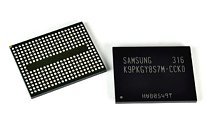- Joined
- Oct 9, 2007
- Messages
- 47,854 (7.38/day)
- Location
- Dublin, Ireland
| System Name | RBMK-1000 |
|---|---|
| Processor | AMD Ryzen 7 5700G |
| Motherboard | Gigabyte B550 AORUS Elite V2 |
| Cooling | DeepCool Gammax L240 V2 |
| Memory | 2x 16GB DDR4-3200 |
| Video Card(s) | Galax RTX 4070 Ti EX |
| Storage | Samsung 990 1TB |
| Display(s) | BenQ 1440p 60 Hz 27-inch |
| Case | Corsair Carbide 100R |
| Audio Device(s) | ASUS SupremeFX S1220A |
| Power Supply | Cooler Master MWE Gold 650W |
| Mouse | ASUS ROG Strix Impact |
| Keyboard | Gamdias Hermes E2 |
| Software | Windows 11 Pro |
Samsung Electronics Wednesday slashed its capital expenditure (capex) by a quarter, which could significantly reduce its NAND flash chip output, and raise NAND flash prices back to profitability for the company, although not anytime soon. This could herald a rise in SSD prices around this time next year, although they partly contradict analyses that predict further slides in NAND flash prices through 2019, as the advent of 96-layer 3D QLC NAND flash by every major player would add to swelling inventories in the market. If you'll recall, Samsung reportedly desires DRAM prices to remain high and establish current high DRAM prices as a new normal. The company went as far as to further reduce its DRAM output, just so supplies of DRAM in the market remain low. The company remarked that acceleration in NAND flash price-drops signifies an end of the "boom" in NAND flash chip demand that fueled growth over the past two years, as justification to its capex cuts.

View at TechPowerUp Main Site

View at TechPowerUp Main Site





 !
! 